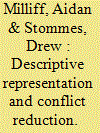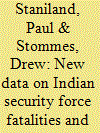|
|
|
Sort Order |
|
|
|
Items / Page
|
|
|
|
|
|
|
| Srl | Item |
| 1 |
ID:
192875


|
|
|
|
|
| Summary/Abstract |
Can greater inclusion in democracy for historically disadvantaged groups reduce rebel violence? Democracy-building is a common tool in counterinsurgencies and post-conflict states, yet existing scholarship has faced obstacles in measuring the independent effect of democratic reforms. We evaluate whether quotas for Scheduled Tribes in local councils reduced rebel violence in Chhattisgarh, an Indian state featuring high-intensity Maoist insurgent activity. These quotas did not originate as a counterinsurgency technique, but instead as an effort to address the longstanding political marginalization of India’s Scheduled Tribes. We employ a geographic regression discontinuity design to study the wartime effects of quotas implemented in Chhattisgarh, finding that reservations reduced Maoist violence in the state. Exploratory analyses of mechanisms suggest that reservations reduced violence by bringing local elected officials closer to state security forces, providing a windfall of valuable information to counterinsurgents. Our study shows that institutional engineering, like reforms to create more inclusive representative democracy, can shape the trajectory of insurgent violence. Institutional engineering creating more inclusive representative democracy during an ongoing conflict can affect the political economy of information sharing in civil war and, ultimately, affect the trajectory of insurgent violence.
|
|
|
|
|
|
|
|
|
|
|
|
|
|
|
|
| 2 |
ID:
167568


|
|
|
|
|
| Summary/Abstract |
National and state-level security forces across India operate against insurgents, criminals, and external threats. These operations are politically consequential, yet these forces tend to be quite opaque. This article provides new data on the fatalities that these forces have suffered in order to explore the location and nature of political violence in India. We create several new datasets of security force fatalities extracted from commemorative security force “martyrs” documents and online databases published by Indian state-level police organizations, the Ministry of Home Affairs (MHA), and the Ministry of Defence, as well as semi-official sources. The data vary wildly in quality and detail, and there are serious limits to their use. Nevertheless, they allow us to – with caveats – measure the location and incidence of violence, as well as the demographic underpinnings of the Indian Army, the two largest MHA paramilitaries, and several state police forces. Caveats aside, we anticipate that subsets of these data are sufficiently high in quality, facilitating future rigorous quantitative analysis on political violence in India. The entire dataset will be made publicly available.
|
|
|
|
|
|
|
|
|
|
|
|
|
|
|
|
|
|
|
|
|